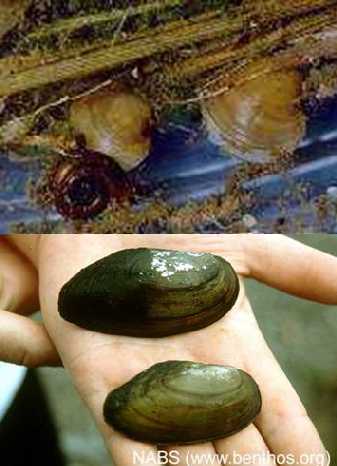Home → Water Quality → Monitoring & Reporting → Biomonitoring → Sampling & Analysis → Macroinvertebrate Types → Clams & Mussels
 Clams & Mussels (Bivalvia)
Clams & Mussels (Bivalvia)
Clams and mussels are a member of the phylum Mollusca, which also includes freshwater snails. Mollusks are identified by their hard calcium carbonate shell which contains a soft body. All mollusks have a muscular foot used for locomotion, a visceral mass that comprises most of the body, and a mantle that secretes the materials that form the shell. Unlike snails, mussels do not have a distinct head. Clams and mussels, collectively referred to as bivalves, can be distinguished from other mollusks by the two hinging shells that surround the soft body. Snail shells are formed in only one piece.
The two types of freshwater bivalve found in Maine are the fingernail clams (Family Sphaeriidae) and mussels (Family Unionidae). At 2-20mm long adult fingernail clams are much smaller than adult mussels, which generally range from 30-250mm. Both types of bivalve have distinct male and female genders and reproduce sexually. Whereas juvenile fingernail clams hatch looking essentially like small adults, newly hatched mussels look nothing like adults. These young mussels, called glochidia, attach themselves to fishes. This parasitic phase does minimal harm to the fish host and serves to transport young mussels away from their parents. Once attached to a fish, glochidia mature into their familiar adult form, fall off the fish, and settle into the much more sedentary lifestyle of adult mussels.
Freshwater bivalves live burrowed into sediment, where they anchor themselves with their muscular foot. The opposite end of the bivalve, containing body-parts called siphons, protrudes out of the sediment. Bivalves use the siphons to create a current of water through their bodies. This current carries in algae and detritus that the bivalve filters from the water and consumes. Dissolved oxygen is also carried in on this water current and absorbed through the bivalve's gills and mantle.
Freshwater bivalves can be found in all sizes of lakes and rivers. Mussels are the most diverse and abundant in the littoral (near-shore) zones of large natural lakes and in shallow areas of medium to large rivers with a moderate current. Mussels generally are not found in springs, small streams, or ponds. They prefer courser sediments, such as sand and gravel, as it is difficult for them to stay at the surface of loose, fine sediment. Fingernail clams are the dominant bivalves in temporary habitats, ponds, and the deeper portions of lakes. They are most common in standing water, although they can occur in all water velocities. Fingernail clams are the most diverse in fine sand, silt, and clay, which provide sufficient support to keep their small bodies from sinking into the sediment.
Fingernail clams are somewhat tolerant of pollution and habitat disturbance. Because they thrive in loose sediments and feed off of algae and detritus they do well in areas that are mildly affected by organic pollution. However, because they breathe dissolved oxygen, they do not do well in severely affected waters with anaerobic sediments (sediments that lack oxygen). Freshwater mussels are more sensitive to pollution than fingernail clams. They do not tolerate accumulated silt and loose sediment from runoff. They are sensitive to changes in stream morphology that affect current, such as dams. Changes in fish communities that reduce the abundance of the fish species parasitized by young mussels also affect mussel communities. Due to these sensitivities, freshwater mussels are one of the few invertebrate groups that contain a large number of endangered species.
Picture key
Top: Two fingernail clams (Sphaeriidae, light brown in photo) and a snail (Planorbidae, dark brown in photo)
Source: The Vernal Pool Association
Bottom: Two freshwater mussels (Unionidae)
Source: The North American Benthological Society
Bibliography
Voshell, Jr., J. Reese; illustrated by Amy Bartlett Wright. 2002. A Guide to Common Freshwater Invertebrates of North America. Blacksburg (VA): The McDonald & Woodward Publishing Company. 442 p.